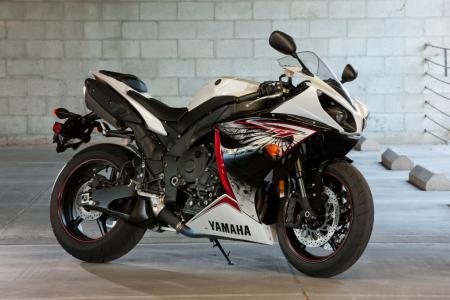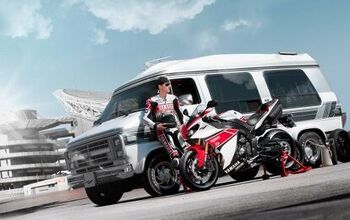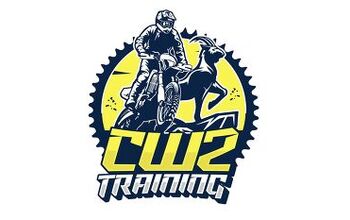2012 Yamaha YZF-R1 Review [Video] - Motorcycle.com
“Take that turn over there as hard as you can. When you get the bike fully on its side, whack the throttle to the stop.”
In my mind I still have the fearless aspiration on a motorcycle that I did when I first started riding, but maybe as I get older my self-preservation instincts have started to form a bigger influence on me. Clearly, executing the above scenario would be a recipe for disaster. In fact, I’ve done it once before.
With the bike firmly on my knee, maximum lean angle achieved and a greedy throttle hand, I twisted my wrist as far as it would go, hoping to get a vicious drive out of the corner to pass the guy in front of me. Instead, my boneheaded move landed me right on my head. I haven’t repeated that move since, but the 2012 Yamaha YZF-R1, now with traction control, gave me a feeling that maybe it was time to give it another whirl. And I did. So much for those self-preservation instincts.
This time around, however, the result was different. Instead of violently spinning the rear tire and going sideways rather than forwards, in a fraction of a second the R1 performed its numerous calculations, determined I was trying to drive out of a turn, and instead of throwing me over the highside, delivered just enough power to the ground to keep me going forward with minimal wheel spin. A believer I became.
Such is the beauty of traction control. Combine that with the R1’s crossplane crankshaft that delivers a seemingly direct connection between the rear tire and the rider, and you’ve got a motorcycle that inspires confidence in spades.
More of the Same
Besides the new traction control system, however, the new R1 is largely the same machine we’ve had since 2009. It’s still powered by the same 998cc inline-Four cylinder engine, using crossplane crankshaft technology derived from MotoGP. Power output remains the same which, according to our 2009 Literbike Shootout, means 146.1 horsepower to the rear wheel at 11,800 rpm. That number was the lowest of the quartet back then, and with new models today knocking on the door of 200 (crankshaft) horsepower, it’s interesting to think Yamaha may have missed the boat in adding more power for this 2012 redesign. Though surely nobody will argue that roughly 150 horsepower reaching the rear wheel is still some serious gusto for forward propulsion.
Both Yamaha’s Chip Controlled Throttle (YCC-T) and Intake (YCC-I) are carryovers to the 2012 model, with the former gaining even more significance with the addition of traction control. If you’re not familiar, YCC-T is corporate speak for electronic or “fly-by-wire” throttle technology, while YCC-I is in reference to the variable intake stacks that extend past a certain rpm to provide maximum torque down low and horsepower up high in the rev range.
More carryovers include the three-position D-Mode, or “Drive Mode,” which, at the flick of a button, alters throttle, fuel and ignition mapping for various road conditions. A, B and Standard mode remain the same, with Standard mode providing the optimum overall performance. “A” mode puts more emphasis on acceleration in low-mid rpm, while “B” mode meanwhile does the opposite – providing a 30% slower throttle response at all openings – for those times when the road ahead is slippery and traction is compromised.
Minor Changes
While the addition of traction control is clearly the most significant addition to the new R1, Yamaha has also decided to clean it up around the edges. Subtle tweaks to the headlight cowling include larger LED position lamps at the outer edges, with reflectors added to the lower portion of the cowling – similar to Audi cars – to bolster the attitude from the front end compared to last year’s model.
All is status quo on the chassis front, save for a new rear spring on the fully-adjustable shock that is slightly stiffer at the beginning of the stroke and softer at the end. Yamaha believes this will improve rear traction while also providing a smoother ride through better bump absorption. Other than that, the chassis remains the same. Steering geometry is untouched, with a 24-degree rake and four inches of trail. Front suspension is still the same with a fully-adjustable 43mm inverted fork, with one stanchion controlling rebound damping and the other compression.
Footpegs also remain the same from last year, with its two-way adjustability allowing them to move up and backward from their standard position 15mm and 3mm, respectively. The pegs themselves are knurled all the way to the tip for better boot grip, something the older model didn’t have. Other minor tweaks include new muffler heat shields and end cap design, which give the rear of the R1 a narrower image. Finally, a new top triple clamp design is inspired by the YZR-M1 MotoGP machine. All told, it would be difficult to notice the difference between the 2012 R1 and its predecessors at first glance; it really takes an in-depth look to be able to tell the two apart.
Paying TributeYamaha is very aware and proud of its racing heritage, which started in 1961. To commemorate its 50th year in racing, the factory MotoGP team ran special red/white liveries, similar to the colors used on its original GP effort, at four races this year. If you attended or paid attention to the broadcasts of the MotoGP race at Laguna Seca this year, you might have noticed Kenny Roberts and Eddie Lawson doing parade laps on R1s with these same liveries. In case you thought those were special, one-off editions, think again. Yamaha is going to produce this bike for the masses. Well, sort of. Only 2000 will be made for worldwide production, delineated by a number plate on the fuel tank. Besides the special color scheme and number plate, the 50th Anniversary Edition will feature gold tuning fork emblems and an accessory sticker kit to mimic the GP machine. Mechanically, however, it remains the same. This treatment will be given to the YZF-R6 as well.
Traction Control
We really should have seen this coming, the new R1 with traction control. Since its redesign in 2009 with the crossplane crankshaft, all the signs were pointing to it. With Yamaha’s Chip Controlled Throttle (YCCT) and three drive modes, all that was left to add was a system to limit unwanted spin from the rear tire. Well, the wait is over. The traction control has six levels of increasing intervention, plus a setting to turn the system completely off. Combine that with the three drive modes, and that makes for a total of 21 different settings to achieve your best lap time.
Yamaha engineers aimed to make this system as seamless as possible, without any unnatural or harsh intervention. By taking advantage of the YCC-T electronic throttle, the system uses wheel and engine speed sensors combined with throttle and gear position sensors, to constantly make calculations to control wheel spin depending on what setting the rider chooses. These four sensors send inputs to the ECU, which then calculates the amount of slip, determines whether this exceeds the preset value, and if so, reacts in four different ways. The system either uses the YCC-T to electronically close throttle valves, cut the fuel injection or retard the ignition timing, in no particular order. The fourth step is the illumination of the “TC” light in the gauge cluster which informs the rider the system is operating if they can’t tell already. These calculations are performed constantly and, according to Mike Ulrich from the testing department at Yamaha, at a “slightly faster” rate than its competitors, though Ulrich was not at liberty to say exactly how fast “slightly faster” is.
It’s important to note that the system does not utilize bank angle sensors. Using the sensors mentioned above, it senses signal changes that indicate tire circumference changes as the bike leans. A slow rate of change indicates the bike is leaning from side to side and doesn’t warrant intervention, as it can only do so at a certain rate. Plus, it’s highly unlikely that a rider is moving from side to side while accelerating at full throttle. The ECU stores this data and references it against the preset slip values for each of the six different TC settings. A faster signal change likely indicates a loss of traction and the need for intervention. Yamaha has calibrated the ECU to recognize and adapt to most popular tire sizes and gearing configurations, though to avoid the legal department working overtime, obviously stays clear of stating that it will work for all tire sizes and/or gearing combos.
That said, an interesting side note about the R1’s electronics package is that, should any part of the system malfunction, the on-board diagnostics will immediately send a specific fault code directly to the gauge cluster. All a certified mechanic will have to do then is simply reference that code to a master list and address the problem. No removal of bodywork needed. It’s likely that tools won’t be needed either. Just a computer.
The goal of traction control is to limit slip which, theoretically, should improve lap times. However, despite how counterintuitive it sounds on paper, tires need a certain amount of slip in a racetrack setting, often to help them finish off a corner by steering with the throttle. Yamaha has taken this into account and feels as though its system in its lower intervention settings still allows plenty of slip if needed.
Hype or Revelation?
Of course, talk is cheap and I wanted to see what the new bike is like to ride. To do that, Yamaha invited journalists to Palm Springs, California for a street ride on the new R1 followed by a day at Chuckwalla Valley Raceway to really put the bike through its paces. On the street the new R1 felt much like the old R1 – because it practically is. The sound coming from the crossplane crankshaft is musical, while the power delivery borders on telepathic. The relatively torquey motor compared to the previous generation (pre-2009) makes leaving stoplights a much easier task for those ill-trained in smooth clutch operation.
In the canyons, the new R1 was a relatively simple machine to pilot. Turn-in doesn’t require much effort, and it holds an arc with ease. An updated version of the Dunlop Qualifier II tire is now spooned onto the wheels, replacing the D210s, and is a specific compound for the R1. I found the tires to be surprisingly compliant over the bumps on the poorly maintained roads we were riding on.
Our street ride came on a particularly warm day in Palm Springs which would test how well the new muffler heat guards really work. One complaint that’s common with motorcycles equipped with undertail exhausts is that the heat radiates directly to the rider, the R1 being no exception. Unfortunately, this still proved true on the 2012 machine. At stops, the engine and exhaust heat combined to toast my legs to medium-rare status. Of course, the triple digit ambient temps on the day didn’t help matters any.
Considering conditions were just about perfect for a street ride, the chance to test the new traction control system would have to wait until the track portion of our test. Which is coming up now...
Hype or Revelation, Racetrack Edition
To save the suspense, I’ll say it up front: Yamaha’s new traction control system on the 2012 R1 works exactly as advertised. I was pleasantly surprised by how seamless it intervenes. Normally when I test motorcycles with traction control, I start the day with the maximum intervention settings so I can feel just how early and abruptly the system kicks in. And normally, I’ll feel the system kick in at a time I personally feel isn’t necessary (say, almost completely upright). That feeling is one of harsh bucking and stuttering as the system limits the amount of fuel or spark to the engine. That harshness kills drive, which ultimately affects lap times. As the intervention settings come down and more slip is allowed, sometimes I can still feel the stuttering from the engine. Some manufacturers have calibrated their settings better than others, and admittedly, many of today’s literbikes that offer traction control have systems that are very linear and much less unsettling for the rider.
Yamaha’s system takes that to another level. Even with the TC settings set to max, forward propulsion is still strong with hardly a hint of stuttering. To put it (and myself) to the test, I relived that fateful day where I whacked the throttle open with the bike on its side. This time around, however, the R1 drove out of the corner as best it could, the indicator light on the dash glaring at me the entire time. That said, the maximum setting still holds the rider back, but this was a good baseline starting point to feel what the system would do under lower settings with less intervention. Levels five and six (the two most intervening modes) also act as a wheelie control.
Changing TC settings is simple, just flick the toggle switch on the left bar. The corresponding gauge on the dash tells you where you’re at. The throttle must be shut to change settings, and to turn the system off, the bike must be stopped and the toggle must be held down for two seconds. In the lower settings plenty of slip is available to leave long, dark black marks on the pavement. For the majority of fast riders out there, they’ll probably enjoy the lower settings the most. However, the best riders and racers will still be able to set their quickest times with the system completely off.
As for the rest of the bike, there’s not much new to report. After some initial suspension tuning, I found that mid-corner stability was outstanding, with the ability to change my line at will. Side-to-side transitions took some slight effort, as its 454-pound wet weight is among the highest in the literbike class. Surprisingly, the addition of traction control added zero weight to the new model compared to last year.
The connection between the throttle hand and the rear tire is an aspect about the crossplane crankshaft R1 we’ve loved since its introduction, and that continues with the new model. I did notice a bit of vibration at low rpm when accelerating out of a turn, but for the most part the vibey nature from the crossplane crankshaft engine is quelled through counterbalancers and is a non-issue.
Brakes on the R1 are also unchanged, which means dual 310mm discs are clamped by radially mounted six-piston calipers that have great stopping power but lack outright feel at the lever. Despite using wheel-speed sensors for the traction control system, ABS is not a feature on the new bike.
My complaints about the new R1 are nothing we haven’t mentioned before on these pages so there’s little point in rehashing them. Traction control is clearly the main talking point here, and deservedly so. It’s among, if not the, best traction control systems that currently comes standard on a production motorcycle. Next year’s literbike showdown will be an interesting one as traction control systems will be a new metric by which to judge the field.
Pricing for the 2012 YZF-R1 starts at $13,990, and climbs to $14,490 for the 50th Anniversary Edition. Expect to see them in showrooms in the coming months.
More by Troy Siahaan








































Comments
Join the conversation